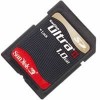SanDisk SDSDH-1024 Product Manual - Page 48
Functional Description, Card Identification Mode
 |
UPC - 710348911073
View all SanDisk SDSDH-1024 manuals
Add to My Manuals
Save this manual to your list of manuals |
Page 48 highlights
Revision 2.2 Chapter 4 - SD Card Protocol Description SanDisk SD Card Product Manual 4.2 Functional Description The host (master) controls all communication between it and the SD Card. The host sends the following two types of commands: • Broadcast Commands- Broadcast commands are intended for all SD cards. Some of these commands require a response. • Addressed (Point-to-Point) Commands- The addressed commands are sent to the addressed SD Card and cause a response to be sent from this card. A general overview of the command flow is shown in Figure 4-7 for the Card Identification Mode and in Figure 4-8 for the Data Transfer Mode. The commands are listed in Tables 415 and 4-16. The dependencies among the current SD Card, received-command and following states are listed in Table 4-18. In the following sections, the various card operation modes will be described first. Thereafter, the restrictions for controlling the clock signal are defined. All SD Card commands, together with corresponding responses, state transitions, error conditions, and timings are presented in the following sections. The SanDisk SD Card has two operation modes. • Card Identification Mode- The host will be in card identification mode after reset and while it is looking for new cards on the bus. SD cards will be in this mode after reset until the SET_RCA command (CMD3) is received. • Data Transfer Mode- SD cards will enter data-transfer mode when their RCA is first published. The host will enter data-transfer mode after identifying all SD cards on the bus. Table 4-1 lists the dependencies between operation modes and card states. Each state in the card state diagrams (Figure 4-7 and 4-8) is associated with one operation mode. Table 4-1 Card States vs. Operation Modes Overview Inactive Card State Inactive Operation Mode Idle, Ready, Identification Card Identification Mode Standby, Transfer, Send data, Receive data, Programming, Disconnect Data Transfer Mode 4.3 Card Identification Mode In Card Identification Mode the host resets all cards, validates operation voltage range, identifies and requests cards to publish a Relative Card Address (RCA). This operation is performed on each card separately using its own command (CMD) line. All data communication in the Card Identification Mode uses the CMD line only. © 2004 SanDisk Corporation 4-4 12/08/04















